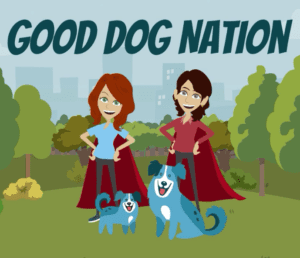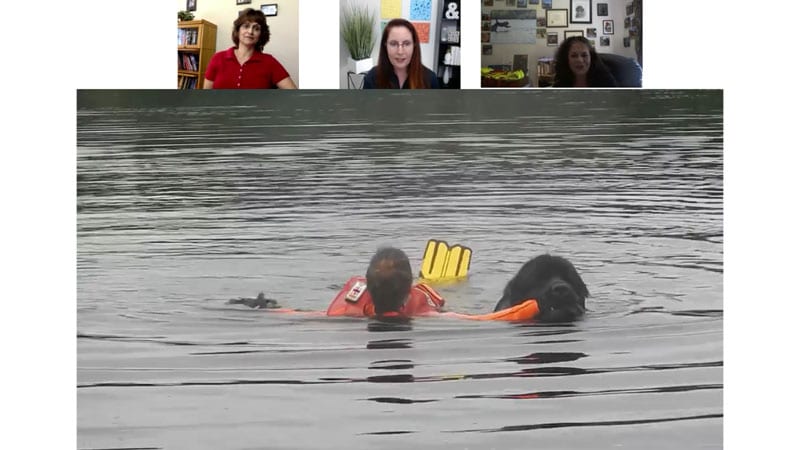Kim: Hello everyone and welcome to the premiere episode of Good Dog Nation, the video podcast that will be covering, all kinds of issues about dogs and the dog community. I’m Kim Merritt, cofounder of Good Dog In A Box and Good Dog Pro. Let me introduce to you my very special cohost for all the episodes of Good Dog Nation, Michelle McCarthy. Hi Michelle, how are you?
Michelle: Hi guys. Great to be here.
Kim: So now let’s get started with today’s episode, lifesaving dogs, canine water rescue, and our very special guest, Maria Gray. Hi Maria.
Maria: Hi. So nice to meet both of you.
Kim: Thank you. So let me give everyone Maria’s bio because it’s really incredible. Maria has been actively training dogs for over 20 years, for the past five years she has worked directly with the SICS, the Italian School of Water Rescue Dogs in Italy where there are over 300 dog handler teams that are certified to patrol the beaches, and work together with the Italian coast guard and fire departments. Maria’s dog is currently the only American dog certified by the SICS, Maria runs a nonprofit organization called the American Academy of Canine Water Rescue, is supported by the SICS, and is dedicated to eliminating unintentional death by drowning. She gives educational seminars around the world to teach people of all ages about water safety, and that’s really the core message here today: water safety. So Maria, give us a little bit of background as far as how you got into this, and what your original interest was in this subject.
Maria: It’s a hard question, but I remember being a little girl, maybe around six or seven, and having one of those golden moments where my parents actually let me watch TV because it was limited back then. I think it was a National Geographic special or a nature channel, but there was a special on PBS that was dedicated to these dogs in Italy that saved people’s lives. And as a young child I grew up with a Saint Bernard, I loved that massive dog and she loved me very much, her name was Wolf, and I was watching this special leaning against her, looking at these dogs leaping off of boats and saving people’s lives. And I thought that’s what I want to do when I grow up. Well, that didn’t happen. I grew up and I ended up getting a PhD in chemical engineering, becoming a wife and mother, but I’ve always had fun with dogs, and I’ve always been a dog trainer. But until my daughter got to be a little more grown up and it wasn’t a dream I really could pursue. I was consistently aware of it, and I’ve had seven Newfoundlands over the course of my life. My most recent, Angel, he came into my life about four-and-a-half years ago. I got him from a breeder who bred both working dogs and show dogs. I believe in rescuing dogs, I also believe in responsible breeders, so I’ll do either way. I have a rescue Aussie in my house, and I have my pedigree working boy Angel, so they all matter. So I got this animal, and I just formed this incredible bond with him as we all want to do with our dogs. And I thought, “I can do this. Now I can finally do this.” And so I contacted [ITALIAN NAME, CAN’T HEAR IT] of the Italian SICS, and I asked, “Can I do this?” And he said, “Absolutely. Come on out.” Well, I couldn’t fly my dog to Italy, so I flew out by myself and they gave me a substitute dog. He was awesome, a black lab named Rambo, and I took this intensive course where I learned all of these training skills that I had never seen before. I know how to train a dog, I trained dogs for therapy, I trained dogs for pet manners, I’ve always done a lot of work with my boys. But in the United States of America, bear in mind, water work with Newfoundlands is carried out as a sport. You take a test, you get your trophy, you get your certificate, and it’s awesome and I celebrate it. And I am a member in good standing of Newfoundland Club of America and I have nothing against them. But what I’m trying to bring to the United States is a very different philosophy. It’s not about a sport. So at the end of the day, if we really do this, we save a life. So we don’t need rules that say you can’t put your foot in the water, or you can’t double command dog, or you can’t touch your dog. In fact, the Italians are all, “Touch the dog! Pull the dog!” They put these dogs on helicopters and they leap out into open water. They’re holding their dogs. I love the AKC, and I mean nothing detrimental, but this is not a test to see if you can’t touch your dog. This is a bond between you and your dog to effectively save a life. So I took that first course, and that was over four years ago, and then I made it my life’s mission to figure out how to get my dog to Italy. We have now been several times, and my Italian colleagues have also come here. Angel flies in the cabin of the plane with me, he is a legal service animal, and this is something I have to say right up front. Please don’t go online and get an ESA certificate if you don’t deserve to have one. Go to a real psychiatrist that you see on a regular basis and get that certification. Don’t pretend your dog is a service dog, it’s not a joke. My dog is a trained service dog, I can demonstrate the service he’s trained to provide for me. I told my rotor cuff, he’s a mobility assistance dog and it’s real. It’s 100% legitimate. He does a bunch more too, my dream is to get him to be a United States military dog. I’m currently in talks with the United States Coast Guard, I’m really looking forward to doing a demonstration for them in the near future, but back to Italy. So back and forth, we went and I kept learning and training and they blew my mind. It was so different than anything I saw in the United States for one thing, they have female and male dogs together, adjacent to one another with no leashes. They allow for some little bit of sparring with the dogs, but they are under full control. I think in this country it would look scary, but I have lived it and breathed it. These dogs are so excited about going into the water, so excited about doing their job. They’re barking and sometimes they even growl, but it’s not posturing, it’s joy and they just want to go. I learned so much from them and I ended up having a back and forth. So each year, for the past four years, two of the instructors from Italy have come to me to train here in Massachusetts. And I’m talking intensive training, I took several tests, I established a new respect for learning new things and seeing the different way they do this. And I was also just floored by the fact that they actually use these dogs in service. I thought whatever you may or may not feel about our country, I still love America, I wanted to bring this here. I want to share this. There are a million ways these dogs can help save lives. They can, and do, save somebody who’s drowning directly in the water, jump off a helicopter, off a boat, off the shore. They also work prophylactically, they work as prevention. So if they’re present on the beach, much like with a lifeguard present on the beach, people are more likely to follow the rules. If you see this dog and his fancy life jacket and you know that he’s there to protect you, whether you’re a child or a grown up, you’re going to be a little more aware of following the rules. Sort of like the police man following you when you’re driving, you’re like, “Okay, I’m going to be safer.”
Kim: And I know, we’ve all had Newfoundlands, Michelle has one right now. My most prized dog was a Newfoundland and I did some of the water work with her with the Newfoundland club. Certainly not to the degree that you are with the SICS, but I remember taking Holly to the beach, and if she was not on a leash, she was in the water rescuing people. Whether it was my children, whether it was whoever was nearby, everybody was being rescued. But because it’s just bred in these dogs, she just absolutely adored the water.
Maria: Absolutely. And maybe now’s a good time to introduce the breed. So a Newfoundland dog, new-found-land, is also called a Terra Nova in Europe. Terra Nova means new earth, very similar to Newfoundland. These dogs were bred, over the last several hundred years, originally utilized by the Vikings to leap off of boats and take the ropes from their boats to the shore so that the Vikings could tie them off. However, it was rapidly discovered that if someone went overboard, the Newf would leap off the boat and go rescue the person, on their own accord. So human beings being as smart as we are figured, “Hey, let’s teach this dog to rescue people.” Their coat is incredibly well-suited for the water, they actually have a three layer coat,. Down near their skin it’s a downey soft layer. It’s almost impossible to wash my dog, it’s incredibly difficult to get them wet to his skin. He’s just designed not to get wet on his epidermis. Above that is a coarser, dense layer that keeps him warm, and above that is a layer of fur that has oil in it, much like a seal. He also has webs between his toes, which allow him to do a freestyle stroke, he doesn’t do a doggy paddle. This is unique in the dog world specifically to Newfoundlands, he actually does something much more akin to a human freestyle. They’re incredibly strong, they’re built for endurance in the water, they’re the only dog breed that can go in Arctic water. However, that said, the Newfie doesn’t rock the world. All dogs count and any dog I will consider in my Academy, and the Italians will as well, consider any dog over 50 pounds at full body weight. You need the mass to rescue somebody. Any dog, whether a mixed breed or a purebred, it doesn’t matter, if you have the right bond with your dog and this moves you, you could pursue water rescue.
Kim: Shall we take a look at a video that shows a dog rescuing an unconscious victim in the water? I find this to be amazing. Let’s watch and then, then you can tell us about this.
Maria: So what you saw there was my partner who’s helping train, that’s [Valentina Pedang de um, ITALIAN NAME] she was here in Massachusetts. She’s an Italian instructor, she went out into the water and feigned unconsciousness. She just pretended she was unconscious. I sent Angel from the shore very quietly and just told him, “Go.” He went out located her hand, and then he’s got tremendous PSI, just like a Rotty or a Doberman. People don’t always understand this with the Newfoundlands, the strength is there, but his natural inclination is gentle. So he’s going to hold their hand as gently as he can. He turns her completely around and he brings her back to shore. There’s no screaming, “Help me dog, save me dog.” She’s silent. She is feigning to be an unconscious victim. It’s the bond between he and I where I direct him out together, and it’s his innate desire to save people. So that’s pretty powerful. The unconscious victim rescue is utilized for real. It’s been utilized by the Italians to actually save people. One of the questions people ask me sometimes is, what about a baby? What about a toddler? Right? My dog weighs 150 pounds, and I think about the bite force associated with that. One of the things Angel and I do for fun is I throw raw eggs at him in the shell, and he catches them and then it gives me back the egg. I didn’t teach him to do this. I guess I do teach sort of that desire to not break the skin. And then to the people who really pushed me, I say, “Okay, so you’re really drowning any he bit your hand, but he saved you. Do you really care? Go get stitches now. Right?” He’s got his rabies vaccine. There are people who ask me, “Do you understand that you might be asking your dog to risk his life?” And the answer is absolutely. So do our first responders. So does everybody. I meet and greet with the United States coast guard and the fire department and the police department. He’s in service and there is a finite risk associated with that, and we’re proud. And I think if he could talk, he’d be proud to tell you. He carries that risk.
Michelle: So when it comes to jumping from helicopters, what type of risk is there for a dog going through that training process? And at what point would you as the handler and the trainers, how are you able to tell if the dog is just really not suited? Just choosing, like, “I just really can’t jump out of this helicopter.”
Maria: That’s an excellent question. So the model that I’m adopting for the American Academy of Canine Rescue, which is brand new, I just started this nonprofit last year. So I’m trying to echo what they do in Italy and adapt it to America because we’re a different country. But in Italy, what I can tell you is first of all, they reevaluate the dogs and their handlers each and every year. So we’re never saying we did this two years ago, so we can still do it. Second of all, the safety of the dog, the willingness of the dog is paramount. We’re not throwing the dog off the helicopter, we’re not throwing the dog out of the boat. In fact, there’s a beautiful video, and it shows several dogs jumping off the helicopter. Then there’s a dog that won’t go, and the video actually says, “And sometimes you’re not ready, but we love you anyway.” So we’re not tossing these animals out. Sometimes looks like that because they are heavily guided off the helicopter, because there’s the engine and there’s blades and there’s a storm. So you’ll see two people who lift the dog up with a special harness and they guide him. But the dog, he or her is willing to jump. If they’re not willing to jump, they don’t jump. And how do you know? You know, just like you ladies know with any kind of training. We’re going to take a cue from the dog because we love the dog. So if the dog is not engaged, if he’s not happy about doing this exercise, we’re going to back up. And some dogs will never do it, and that’s okay. And I want to be very clear about the helicopter. In point of fact, my Italian colleagues recently made this very clear to me, I don’t want to misrepresent it. They save lives every year in Italy, they don’t shave them by jumping off of helicopters. The helicopter is, first of all, super expensive, and second of all, they’re utilized basically to mimic a storm. The dogs do go out in hurricanes and harsh weather, et cetera, to save people. You didn’t pay attention to the rule, you drank too much, you went out on your kayak in the middle of impending weather. Now I have to go save you and it’s stormy and there’s thunder and lightning. We don’t typically train in thunder and lightning. Why? Because it’s dangerous. But that’s a place you need to be able to save. People utilize helicopters creates a storm. So when you’re above the water and your dog is on that helicopter, those blades are spinning, you’re getting hit by the droplets of water, they actually hurt, and you can’t hear anything and it’s basically a controlled storm. So the primary use of the helicopter is a controlled training environment to replicate bad weather. And could these dogs be deployed from helicopters? Absolutely. Have they been deployed? Yes, for exercises. So I just want to be very clear about that. The rescues to date are off of boats. They’re from shore, they’re off of jet skis. With Angel, they were on a jet ski ride, literally they have a special platform and go around this Lake in Italy. On the Italian coast guard boat that I was on, this amazing woman, her name is [Donna Tella, Pascal age ITALIAN NAME], she’s been the vice president of SICS for the past 30 years. We’re in this boat and she goes, “Maria, look, going to go very fast. Be calm for angel.” Okay, very fast. 90 degree angles, sideways, upside down, my dog’s fine. I’m like, “Yeah, mommy loves this.” Because of course, as you know with dog training, you need to project the calmness that you want your dog to experience. So you can’t freak out here. This was an awesome experience just getting him acclimated to the noise, to the presence of it.
Kim: Can you tell us a little about Superpower Dogs? The IMAX movie that has recently come out.
Maria: Yes, there’s Angel. Angel and I have been to the Baltimore Museum of Science, we’ve been to the Virginia Air and Space Museum, and we were incredibly honored to be invited to the Smithsonian Museum in Washington DC to give several talks on water safety prior to each showing of the movie. This movie is incredible and I recommend it to everyone. It’s this tale of how these different dogs and service organizations all over the world save and help us every day. And I liked this movie for so many reasons. One, it’s just powerful and beautiful. But two, it raises public awareness that these dogs work every single day of the year, and they don’t get any money. Almost everybody featured in this movie represents a nonprofit organization, they’re not getting paid. Yes, SICS in Italy is it post civilian protection unit, they don’t get paid to do this. The beautiful surf dog Ricochet who works with PTSD and children with autism, she doesn’t get paid to do that. The dogs in Africa helping to stop poaching, they don’t get paid to do that. Halo, who’s featured throughout the movie, starts out with a little pup. She’s a little Dutch shepherd and her mommy, Kat, who’s this beautiful, powerful woman and works with a fire department somewhere. She teaches this dog to do search and rescue after fires. Again, she does this on her own time. So one of the big messages in the film is to raise public awareness that nonprofits really need to be funded, and if they’re not funded, they will ultimately go away. And people who are basically giving out of their heart and soul to help you, and they’re trying to do something of import that impacts humanity. We need funding. I don’t know when the appropriate time to talk about drowning is, but maybe this is a good time. There are 400,000 people a year who die every year from unintentional death by drowning, that’s from the world health organization. And the truth is, that number is probably really low because a lot of third world countries don’t properly report their statistics. We know from the Center for Disease Control here in the United States, that 10 or more people in America die every single day from unintentional death by drowning. That’s around 4,000 people a year and it’s 100% preventable. It’s particularly tragic because it is a silent killer, and it’s a silent killer in two ways: it’s silent because there’s no public awareness, and it’s also silent because you don’t usually drown going, “Help me, dog! Save me!” There are signs of drowning, which I’ll bring up right now for anyone who’s ever on a beach. If you see someone trying to climb out of the water, if you see someone with their head back, if you see someone go under silently, it’s a sign of drowning. So what can you do? You, whoever you may be, if you’re at the water’s edge and you see the signs, you can alert authorities. You should NOT go and rescue anyone if you don’t have training. But you can do things. If you have access to a flotation device, you can throw it. The Red Cross Says “throw, don’t go.” Don’t go out there unless you’re trained to do so because you don’t want to add to the problem. It’s a tragic situation right now because it’s almost up there with malnutrition and malaria, but we don’t have public outcry. We don’t have public awareness about drowning. And when I said 400,000 people globally a year, what I’m not mentioning is eight to 10 times that many who are subjected to a drowning event, and even if they get rescued, may have permanent brain injuries, may have permanent, serious complications. This is a huge number of people that are being affected by something that really could be eliminated.
Kim: So what do we tell people to do when they’re near the water? What’s the best way to stay safe?
Maria: The best thing you can do when you’re near the water is enjoy it. Have fun. Water’s awesome. I want everyone to play in the water, I want everyone to have fun. But there are basic rules that are really simple, even though they’re not always so exciting. First of all, don’t swim in unfamiliar water. Second of all, learn to swim. The leading cause of drowning is the lack of ability to swim. And I don’t mean you have to be an Olympic swimmer, just the ability to do a doggy paddle can help keep you alive. A lot of people, particularly savvy and disenfranchised, will introduce children to a water setting and aquatic setting with no education. You need to learn to swim. Next, any type of water activity outside of a pool that supervised by a lifeguard should be done with a life jacket. Wear a life jacket. Even if you think it makes you not look cool, even if you think it’s silly. Angel wears a life jacket. I wear a life jacket, I wear a wetsuit. Next point, and I know it sounds overdone, but I’m going to say it out loud. Do not drink and kayak. Do not drink and swim. Do not drink and go out in the water. 80% of drowning deaths in the United States of America are grown men over 40, whether you like the statistic or not, because they get drunk and go out on the water by themselves and then they die. And we can stop that. We can eliminate that. Sadly it’s a leading cause of death in children, particularly in the one to four age range. It is the leading cause of death other than congenital defects in children. And that’s because moms and dads use a pool as a babysitter. A pool is not a babysitter, a pool as a place to be ultra vigilant with your children. There are other basic factors, Americans are at a great risk when they’re traveling abroad and that probably goes to the partying thing. I don’t know that for certain, but they travel abroad and they swim in unfamiliar bodies of water and they’re celebrating so God knows how they’re celebrating. And there’s also other things. Autistic children are at a very high risk for drowning and there’s another way that we can help educate them and teach them. This is where the dog can be very valuable in helping the child to understand the seriousness of playing in the water. There’s so much to say about this topic. Cold water shock is another leading cause of death. So it’s getting hot and you want to jump in the ocean, you jump in the ocean, but the ocean isn’t hot yet. It’s early summer and you jump in. The ocean is freezing cold and you can actually die of something called cold water shock. There are so many things that we need to address, but the fundamentals are pay attention to lifeguards, wear a life jacket, don’t be impaired when swimming, check the weather, and swim with a buddy. Don’t swim alone, swim with another person. Honestly it seems so simple, but you could break it down like that. Swimming, lifeguard, protected beaches. If you’re going to take a risk, take a risk with a buddy. Don’t be impaired, wear life jacket, look at the weather, know your surroundings. And I could keep going, but we can all make a difference if we understand the signs of drowning, which are limited. It’s hard to always be responsible. Don’t try to save anyone’s life without training, but let authorities know. And I don’t want to sound like I’m saying don’t go in the water though. Water’s awesome. Have fun in the water, but respect it and respect yourself.
Kim: Awesome advice for everyone. Maria, please give us the contact information for your American Academy of Canine Water Rescue if somebody wants to get in touch with you or they’re interested in more information about how to get involved.
Maria: Absolutely. So you can reach me directly through email, MariaGray@AcademyofWaterRescue.org, and you can also find me on the web at TheAcademyofWaterRescue.org. If you go to Facebook, you can type in the full name, American Academy of Canine Water Rescue, and I’ll pop up. If you have trouble finding me on Facebook, you could also type in Maria E. Gray, that’ll bring in my personal page, which is heavily cross-linked to my Facebook.
Kim: Thank you so much for being a guest today on our premiere episode and for sharing all this wonderful information, not only about Newfoundlands, what you’re doing with the SICS, and what you’re doing here in this country for water rescue, but also water safety, which is super important for everyone. If you’re interested in continuing the conversation with us and the second half, go to GoodDogPro.com, we’ll be continuing with more information on this subject for our dog professionals. Thank you everyone for joining us.
Kim: If you’d like to participate in the rest of today’s conversation for professionals who work with dogs and receive continuing education credits from participating organizations for listening, visit GoodDogPro.com and subscribe today. Use coupon PODCAST to get 40% off your first month or annual subscription.
Michelle McCarthy, CDBC, has been the Owner and Director of Training for K9 Home Schooling since 1999, which provides force free/clicker training methods in southeast Michigan. She is a nationally recognized Certified Dog Behavior Consultant and Certified Therapy Animal Consultant with the International Association of Animal Behavior Consultants (IAABC). She has completed advanced certification programs in canine behavioral studies and has 18 years of experience working with complex behavior problems. For the past 10 years she has worked closely with medical professionals and educators who utilize a Therapy Dog at their work place or in Animal Assisted Play Therapy. She has raised, trained and placed Therapy Dogs who work in medical facilities and private practices around the US.
Kim Merritt is a serial entrepreneur who started her first company, Kim’s Khocolate, at eleven years of age. As a teenager, she was discovered by Guy Kawasaki who invited her to make custom Khocolate for Apple. Kim went on to do business with The Rolling Stones, AT&T, MCI, Becton Dickinson, Bausch & Lomb, and Range Rover. Her second company, an e-commerce play, sold brand name dinnerware and home decor items across North America. She founded Good Dog in a Box with her sister, professional dog trainer Jenn Merritt, CPDT-KA. Her love of dogs and kids has pushed her to develop and co-develop a number of products, online training courses, and curriculums revolving around dog bite prevention and dog safety. Her latest endeavor, Good Dog Pro, is a subscription based online education system and community for dog professionals.
Check out our kid and dog friendly, reward based training tools at Good Dog in a Box!
Share with us how your family and friends have used Good Dog in a Box! Share your pictures on our social media. We’d love to hear from you. Let’s keep kids and dogs SAFE together!
Subscribe to Good Dog Pro for Full Access to Our Video Podcasts
Good Dog Pro members get full access to both our video podcasts, plus 200+ reward based training videos, dog bite prevention and humane education curriculums, discounts of up to 75% off Good Dog products and courses, webinars, and so much more!










Leave a Reply
Want to join the discussion?Feel free to contribute!